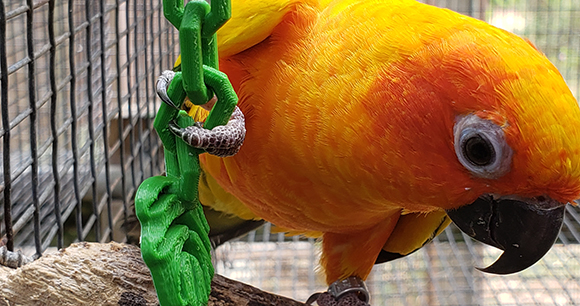3D Printing for Animal Welfare
Enrichment—adding complexity to an animal’s environment—is an essential element of improving the lives of animals in captivity. Species-appropriate toys, puzzles, and structures, for example, can provide cognitive stimulation and opportunities to engage in natural behaviors. Animals deprived of such opportunities may engage in abnormal, often harmful activities out of boredom and frustration.

Enrichment items often have to be rotated or replaced, and providing a continual variety of enrichment—especially, custom-built enrichment—can be costly and time-consuming. If the animals “consume” the enrichment faster than the caregivers can construct and install it, the animals may remain stressed.
For custom-made objects, 3D printers may prove useful in keeping up with demand—once a design is acquired, objects could be printed as needed—but there isn’t much history of their use as an animal welfare tool. In a series of studies funded by an AWI Refinement Grant, I carried out experiments and demonstrations to better understand how 3D printing can and can’t benefit animal welfare.
My first concern was whether 3D-printed objects would absorb wet grime or concentrate cleaning chemicals. I tested absorption during cleaning for four types of printing and finishing, across four types of filament—PLA, PETG, PVB, and ABS—for a total of 160 samples. Samples were placed in a sanitizing soak, dried, and weighed. Watertight printing (extra material printed at a higher temperature) absorbed significantly less than normal printing. Chemically smoothed prints absorbed even less. However, ABS plastic prints lost weight during smoothing and sanitizing, a safety concern. Plastic might be leaving the item and be consumed.
The printable plastic was tested for heavy metal toxicity and endocrine disruption next, before and after being printed by six printer models. Metals tested were antimony, arsenic, barium, cadmium, chromium, lead, mercury, and selenium. After printing, the toys contained up to 6ppm barium, 8ppm arsenic, 11ppm lead, and no other metals. To understand the risk, I referenced ASTM safety standard F963-17 for toys containing modeling clay—as clay can be eaten by children and, consequently, its metal levels are strictly regulated. None of the heavy metal concentrations found exceeded this standard, suggesting this is not a concern.
The four types of printable plastic were then tested for endocrine disruptors—BPA and eight phthalates regulated under the US Consumer Product Safety Commission. Phthalates were not detected in any filament. A trace amount of BPA was found in the PETG (< 1ppm, considered the detection threshold by the State of Washington).
Based on the these results—heavy metal concentrations low enough to meet a safety standard established to safeguard children and almost no evidence of endocrine disruptors—I would be comfortable creating hutches, exercise devices, climbing structures, etc., from 3D prints that would be chewed on by animals and used around infant animals (especially if food-safe-certified or virgin materials are used to reduce any toxicity that may arise from added colorants).
Multiple examples of 3D printed materials in use can be found in this study’s full report, available in AWI’s Refinement Database.
This study was funded by the AWI Refinement Research Award program. Learn more about this program or to view additional studies.
Program Terms: Animals in Laboratories
AWI Quarterly Terms: Feature Article
Related News
New Analysis: Animal Welfare Act Enforcement Deteriorates Following SCOTUS Ruling
In Program: Animals in LaboratoriesThe US Department of Agriculture, long known for its lackluster enforcement of the Animal Welfare Act (AWA), appears in recent years to have drifted even...
AWI Statement on Trump Administration’s Plan to Reduce Animal Experimentation Amid Attack on Science
In Program: Animals in LaboratoriesThe Animal Welfare Institute (AWI) applauds recent announcements by the National Institutes of Health and the US Food and Drug Administration about their plans to reduce the use of...
AWI Scholarship Winners Campaign for a Better World for Animals
In Program: Animals in Laboratories, Farmed AnimalsThe Animal Welfare Institute (AWI) announced today the 12 winners of a scholarship designed to invest in future leaders who seek to improve the lives...
AWI Supports Phasing Out Animal Use in Research and Testing, but Proper Planning is Essential to Protect Animals and Science
In Program: Animals in LaboratoriesLast month, both the National Institutes of Health and the US Food and Drug Administration announced plans to phase out the use of animals in...